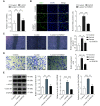Histone lactylation promotes cell proliferation, migration and invasion through targeting HMGB1 in endometriosis
- PMID: 37945340
- PMCID: PMC10687535
- DOI: 10.7555/JBR.37.20230095
Histone lactylation promotes cell proliferation, migration and invasion through targeting HMGB1 in endometriosis
Abstract
Endometriosis is defined as a condition with endometrium-like tissues migrating outside of the pelvic cavity. However, the mechanism of endometriosis is still unclear. Lactate can be covalently modified to lysine residues of histones and other proteins, which is called lactylation. The results showed that the higher level of lactate and lactate dehydrogenase A enhanced the histone H3 lysine 18 lactylation (H3K18lac) in ectopic endometrial tissues and ectopic endometrial stromal cells than that in normal endometrial tissues and normal endometrial stromal cells. Lactate promoted cell proliferation, migration, and invasion in endometriosis. Mechanistically, lactate induced H3K18lac to promote the expression of high-mobility group box 1 (HMGB1) in endometriosis, and HMGB1 knockdown significantly reduced the cell proliferation, migration, and invasion of the lactate-treated cells through the phosphorylation of AKT. In conclusion, lactate could induce histone lactylation to promote endometriosis progression by upregulating the expression of HMGB1, which may provide a novel target for the prevention and treatment of endometriosis.
Keywords: ESCs; HMGB1; endometriosis; lactate; lactylation.
Conflict of interest statement
The authors reported no conflict of interests.
Figures






References
LinkOut - more resources
Full Text Sources

